
9 minute read
KPMG Report on Medical Device Outlook to 2030
KPMG REPORT ON MEDICAL DEVICES 2030
KPMG International’s Global Strategy Group has issued a report looking at the prospects for the medical device sector to 2030. They note that the overall picture looks positive, although rising healthcare costs and new competition will be counterbalancing factors. Below are the excerpts: to see the entire report, go here.
Advertisement

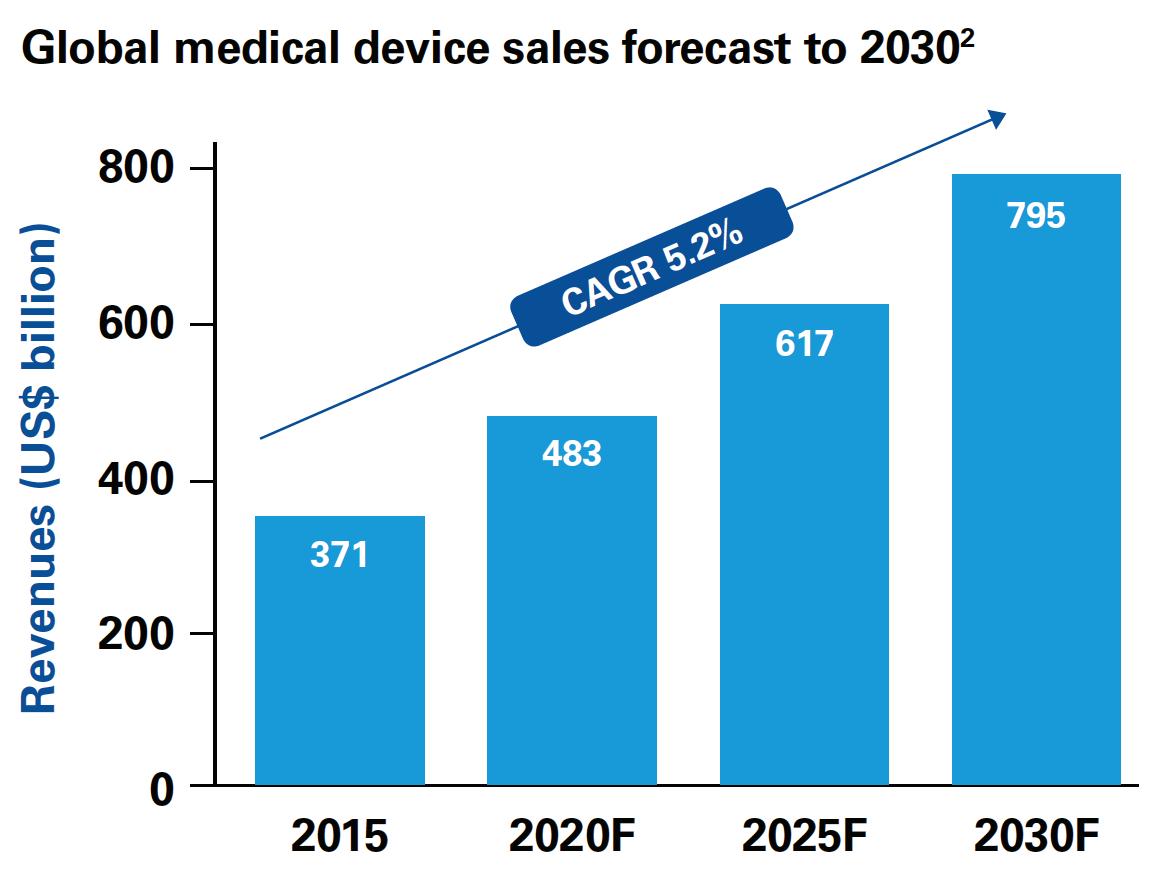
(Figure 1)
DON’T GET STUCK IN THE MIDDLE
Unbearable pressures disrupt status quo:
The medical device industry is poised for steady growth, with global annual sales forecast to rise by over 5 percent a year and reach nearly US$800 billion by 2030 1 . These projections reflect increasing demand for innovative new devices (like wearables) and services (like health data), as lifestyle diseases become more prevalent, and economic development unlocks the huge potential in emerging markets – particularly China and India. (Figure 1) Despite these apparently attractive prospects, a shadow hangs over the sector in the form of a relentless downward pressure on pricing. Governments around the world are desperately trying to reduce the cost of healthcare – especially in the most expensive part of the system: hospitals. They want to pay less for medical devices and see proof of greater value in terms of better patient outcomes. Responsibility for many purchasing decisions has already moved from clinical to economic buyers. Short- term respites like the 2-year US excise tax moratorium on medical devices notwithstanding, pricing appears to be going in one direction only – down. Further uncertainty lies ahead, with the new European Medical Device Regulation in 2020 and regulations in China that are designed to spark local innovation. These developments present a quandary for medical device companies that have historically concentrated on manufacturing and research and development (R&D), but are now seeing healthcare budget restrictions and new reimbursement regimes continue to snip away at margins. On top of this, new players – some from entirely different industries – are disrupting the sector by harnessing data to take ownership of customers, patients and consumers. In this volatile new marketplace, today’s device players are in serious risk of being stuck in the middle of the value chain, as mere commodity producers.
Technology innovation at an unprecedented pace:
Patient and consumer data sharing technologies will be further complemented by a host of innovations across the following medical device categories:
Innovative surgical interven
tions like autonomous robots and intelligent balloon catheters will enhance outcomes of complex surgeries and enable new forms of minimally invasive surgeries. Stryker has placed large bets in this space, given their strong orthopedics focus. In March 2017, the company launched the robotic-arm assisted total knee arthroplasty application for use with its Mako robot system. The technology is the first of its kind for total knee replacement, gained FDA approval in 2015 and is now commercially available for use in the U.S. 2
Ingenious diagnosis and imaging
will utilize DNA, nanobots and Artificial Intelligence (AI) to speed up diagnosis, imaging and importantly, subsequent care decisions. Some of the aforementioned new entrants will be at the forefront of introducing AI into healthcare delivery. Already, Google is working on using deep learning, a branch of AI, to recognize patterns in a huge number of digital representations of images in order to detect signs of cancer in breast cancer
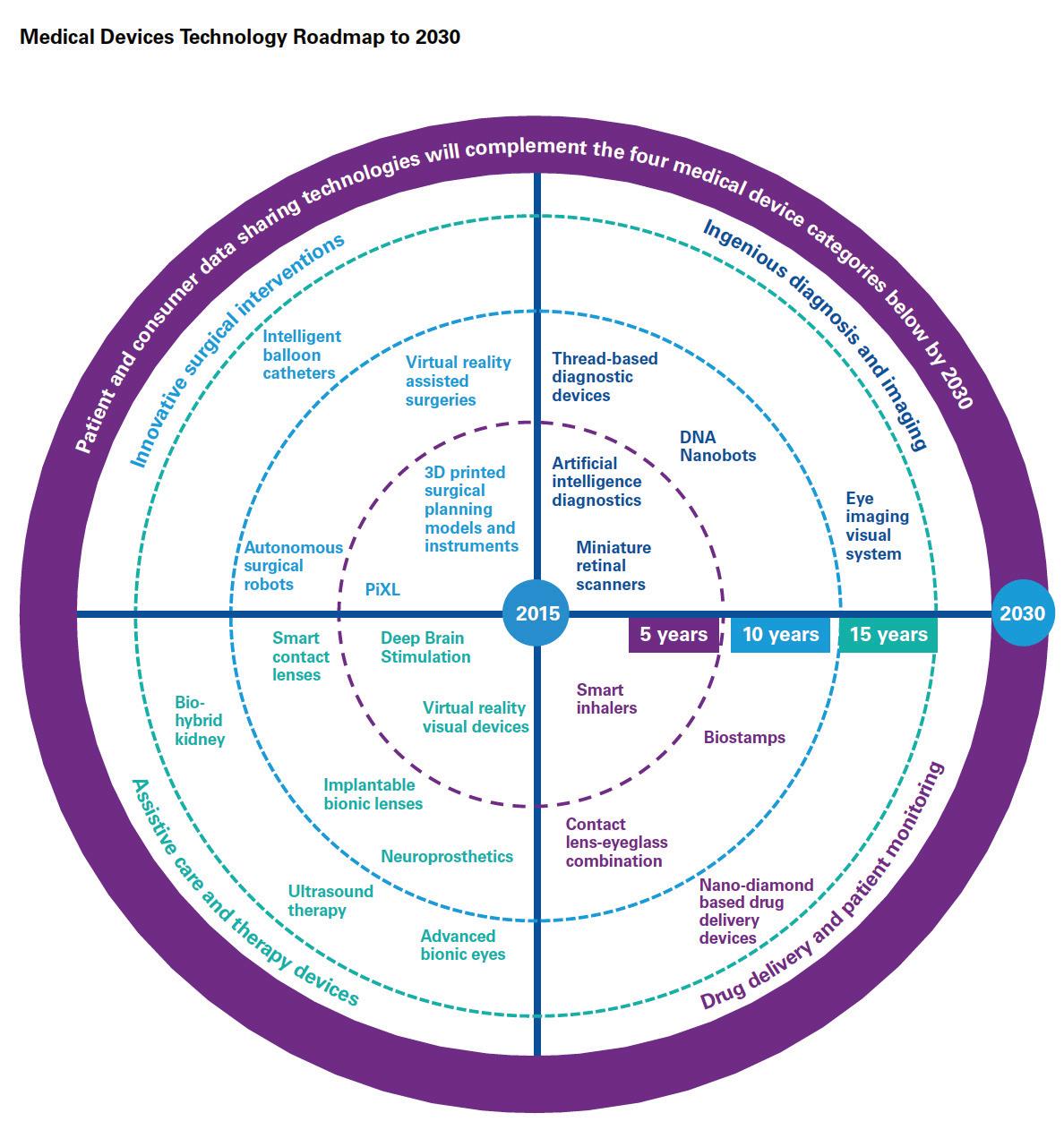
biopsies 3 . The technology is still in its nascent stage of R&D but has the potential to make a big impact on the imaging segment.
Drug delivery and patient moni
toring will personalize and minimize invasiveness of drug delivery, through devices like biostamps and smart inhalers. Several pharmaceutical and technology companies are currently developing connected inhalers. These smart devices will not only send the patient medication reminders (thereby improving adherence) but also transmit data to their physicians, enabling more personalized and preemptive care. Novartis has partnered with Qualcomm Life to develop an internetconnected inhaler (known as the next generation Breezhaler) that can send information to a cloudbased big data analytics platform which healthcare providers can use to treat patients with chronic obstructive pulmonary disease (COPD). The company plans to launch the Breezhaler in 2019 following manufacturing, testing and regulatory approval 4 .
(Figure 3)
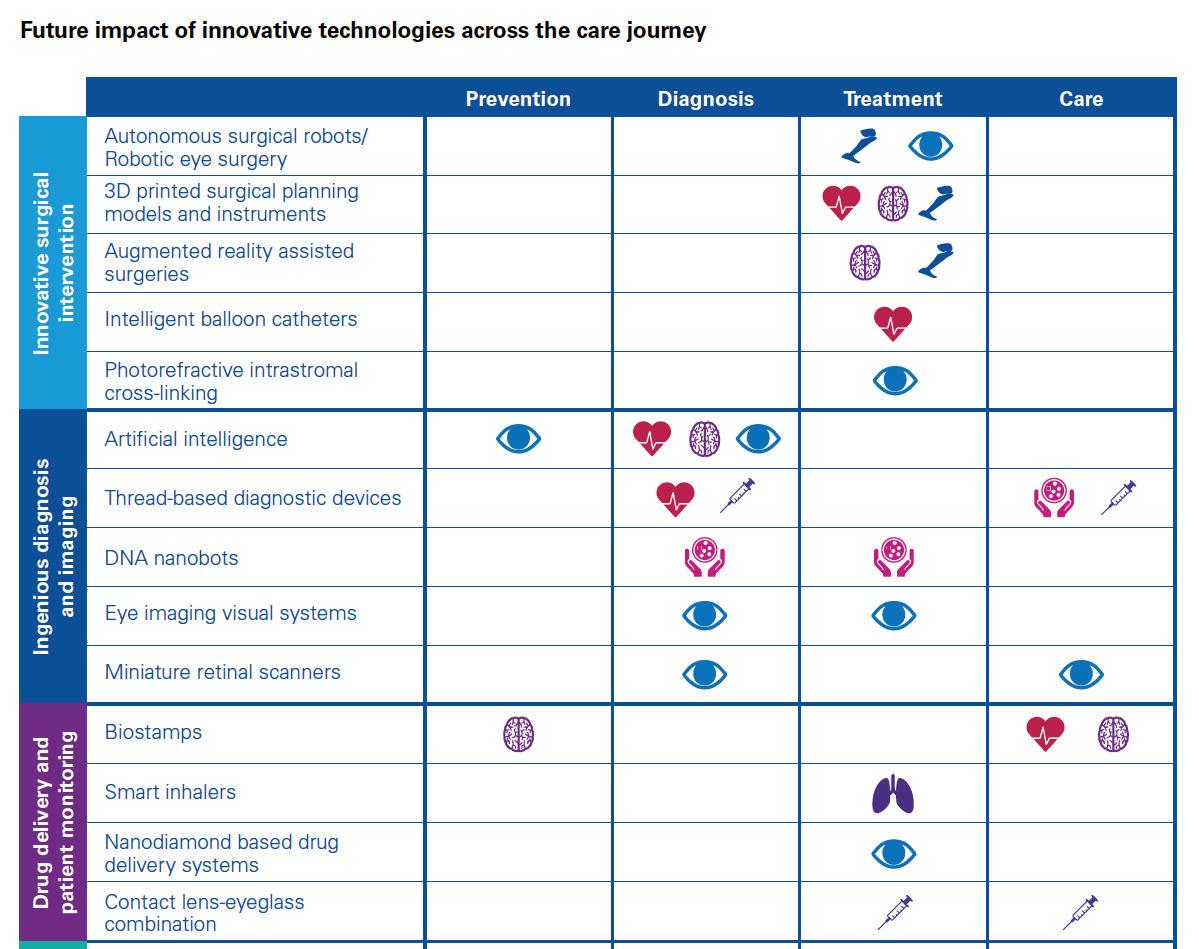
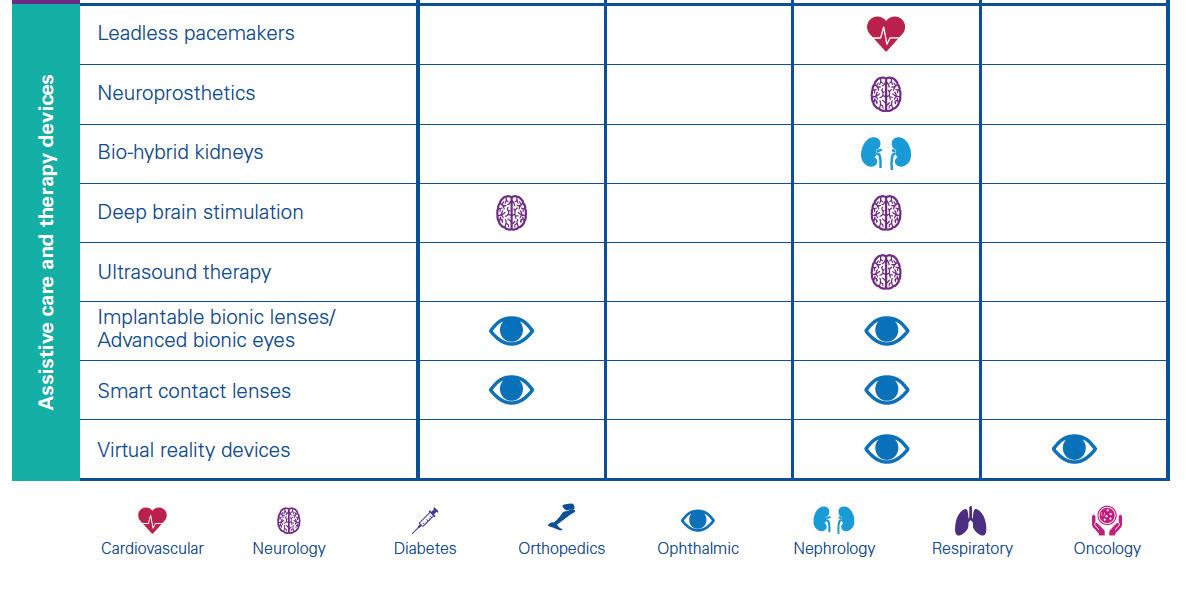
Assistive care and therapy services
– like the bio-hybrid kidney – will minimize the need for certain services (e.g. dialysis) and also reduce many of the patient risks associated with today’s systems. Researchers at the University of California have developed a first prototype of an artificial implantable kidney the size of a coffee cup. It contains microchip filters developed by silicon nanotechnology and living kidney cells that will be powered by a patient’s own heart, further ensuring a zero percent chance of organ rejection 5 . These are just some of the many exciting ways in which technology will impact the medical devices sector by 2030. Deal strategies over the coming decade should therefore include cross-sector opportunities, to identify winning partnerships that can radically transform healthcare delivery through better care at lower costs.
(Figure 4)
New markets:
Although the US will continue to dominate the medical device industry in 2030, crossing US$300 billion in sales 6 , the top five markets will also include China (in second place, with more than 25 percent of the global market at over US$200 billion 7 ) and India (fifth largest, with over US$40 billion in revenues 8 ). China and India are already growing at twice the pace of the overall market, driven by healthcare reform, local government incentives and overall rising demand for healthcare 9 . Both countries are also fast becoming innovation hubs – India is already known as the global center for frugal engineering, producing a number of indigenous (and low cost) devices with global market potential. The diverse nature of different emerging markets calls for indi
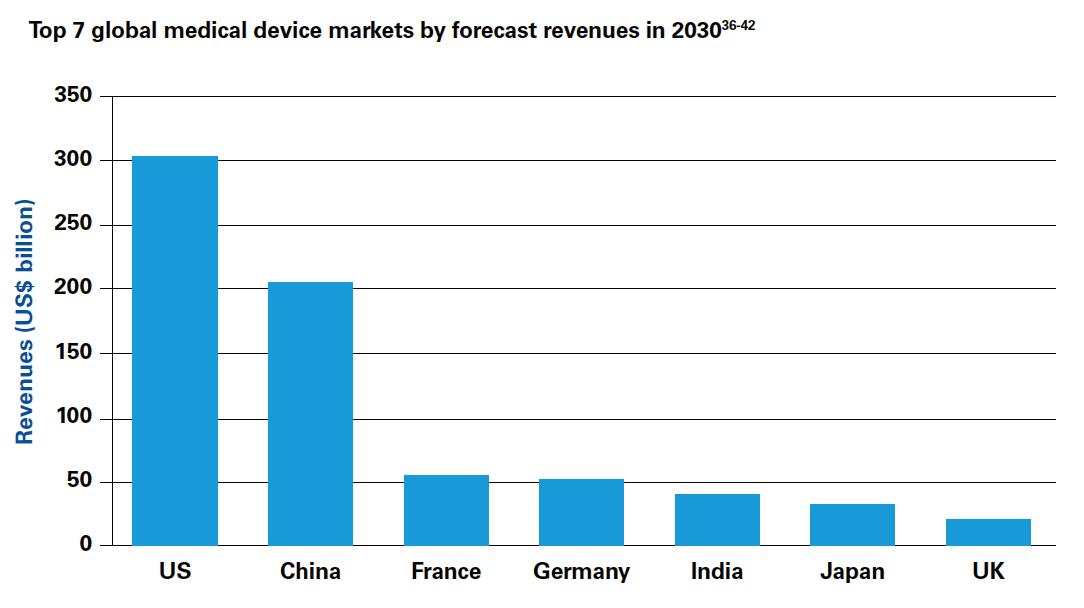
vidual entry strategies tailored to specific in-market needs. Key success factors include localizing innovation and manufacturing, adapting to country-specific distribution models and sales channels, investing in local technology infrastructure and collaborating with domestic value chain stakeholders. Medical device companies will need to be prepared to invest for the long run, adding complexity and uncertainty to their expected pay-offs – but inaction could see them missing out on potentially lucrative opportunities. While China and India are obvious choices to establish and strengthen presence, other markets should consistently be evaluated as they continue to grow over the coming decade. (Figure 4) STAYING AHEAD IN 2030 So what does this all mean for your medical device company?

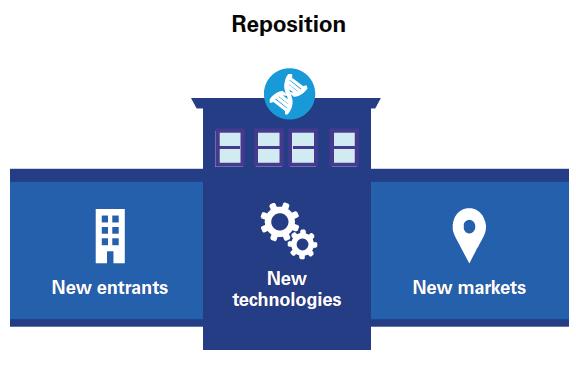
What can you do to kick-start journey towards 2030, and realize the “Reinvent-Reposition-Reconfigure” strategy? In order create a winning configuration going forward, companies should consider following recommendations:
Define your new value proposition:
Decide the combination of products, services and intelligence

which differentiate your company in the minds of customers, patients and consumers. Offerings should be designed following a “user-back” rather than a “deviceforward” approach. Constantly evaluate and upgrade the global portfolio. Prevention should be considered more important than treatment and cure over the coming decade, with companies delivering far beyond the device – increasingly to consumers, in addition to physicians and patients. The value proposition in 2030 will not translate solely into revenues and margins – it will mean protecting and creating market share. And it will involve relationships based on trust, where medical device companies are not just servicing their customers, but advising them along each step of their individual care journey.
Invest smartly:
Proactively understand the impact of future technologies on your global business. Be open to new ideas and pilots in order to test concepts, with the corresponding ability to fail fast and scale quickly as needed. By investing in a strong interoperable digital infrastructure and harnessing data, companies can both expand their business models and position themselves to compete in a transformed environment. A strong decision framework should support build versus buy choices, and a robust technology roadmap should inform the pathway from data to intelligence. Medical device companies should also continuously incorporate learnings from industry peers as well as best practices from other sectors.
Collaborate and establish an ecosystem
Executing on business and operating model choices will likely require capabilities from an expanded external network. While M&A activity intended to build scale and diversify portfolio will continue, the shift to services and intelligence should generate deal activity focused on establishing corresponding capabilities, both within and outside the value chain. Companies will need to institute a systemic process to identify strategic alliance partners and an internal capability to effectively manage their ecosystem. Collaborate widely, including cross-sector, conduct joint experiments and even consider coopetition to meet the goals for your chosen configurations.
Adopt a flexible, modular organizational structure:
This doesn’t mean that large multibillion dollar corporations should operate as start-ups, but it requires active steps towards a more agile and nimble organizational structure. In a dynamic environment, medical device companies will need to react quickly to market opportunities and move at “deal speed” to realize value from growth transactions. Processes should be streamlined and people empowered. While ensuring adequate levels of governance by segment, allow for faster decision making – especially as it relates to the portfolio (products, services and intelligence) and technology.
Don’t let your past dictate your future:
Challenge the traditional ways of operating your business, and try novel approaches. Develop a deeper understanding of the end user and their emerging needs, and create different scenarios of how your business might look like in 2030. By attempting to disrupt themselves, medical device companies can stay a step ahead of emerging competitors and not wait for the ‘how to win’ playbook to be rewritten. It is entirely possible (and probable) that in the future, a multi-thousand dollar machine will be displaced by a portable device that costs less than US$100. •
1 Market size extrapolated from World Preview 2016, Outlook to 2022, EvaluateMedTech, October 2016 http://info.evaluategroup.com/rs/607-YGS-364/images/mt-wp16.pdf 2 Stryker launches Mako robotic platform total-knee application, Mass Device, 14 March 2017 http://www.massdevice.com/stryker-launches-mako-robotic-platform-total-knee-application 3 Google Can Help Detect Breast Cancer Using Artificial Intelligence, MIT Technology Review Pakistan, 6 March 2017 http://www.technologyreview.pk/google-can-helpdetect-breast-cancer-using-artificial-intelligence 4 Qualcomm expands collaboration with Novartis for connected COPD therapy, Qualcomm Press Release, 5 January 2016 https://www.qualcomm.com/news/releases/2016/01/05/qualcomm-expands-collaborationnovartis-connected-copd-therapy 5 No More Dialysis, Scientists Have Developed A Bionic Kidney, Medical-Online, 3 April 2017 http://www.medicalonline1.com/2017/04/03/nomore-dialysis-scientists-have-developed-a-bionickidney 6 USA - Overview of medical device industry and healthcare statistics, Emergo website, accessed on 15 November 2017 https://www.emergogroup.com/resources/marketunited-states
7 China - Medical Devices, China Country Commercial Guide, US export.gov website, accessed on 15 November 2017 https://www.export.gov/article?id=China-MedicalDevices
8 India can be among world’s top 5 medical devices markets, Business Standard, 15 February 2017 http://www.business-standard.com/content/ b2b-pharma/india-can-be-among-world-stop-5-medical-devices-markets-himanshubaid-117021500535_1.html
9 China - Medical Devices, Country Commercial Guide, US export.gov website, accessed on15 November 2017 https://www.gov/article?id=China-Medical-Devices Manufacturing in India: A Sunrise Segment, Khaleej Times, 30 January ibef.org/arab-health-2017/ download/EEPC-IBEF-Arab-Health-Supplement30-Jan-201.pdf








